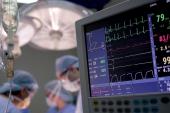SCAI Updates Position on Doing PCI Without Surgical Backup
The types of cases performed at centers without on-site surgery should be largely based on the center’s rescue capabilities.

The Society for Cardiovascular Angiography and Interventions (SCAI) has updated their recommendations for performing PCI at centers without surgical backup, proposing a new algorithm that factors in the patient’s clinical profile and lesion risk as well as the rescue capabilities of the institution.
Unlike previous statements, SCAI is not explicitly providing formal criteria to restrict the type of PCI that can be performed or the patient subgroups that can be treated at these centers. Instead, the document offers recommendations about higher-risk cases that may be best suited to centers with on-site surgery.
Cindy Grines, MD (Northside Hospital Cardiovascular Institute, Atlanta, GA), who chaired the writing group, said there are data from both randomized trials and large observational studies showing that PCI, even for increasingly complex cases, can be safely done at centers without surgical backup. Prior consensus recommendations for PCI-only centers were conservative, but “given the change in practice patterns, as well as the change in reports showing good outcomes, we felt an update was warranted,” Grines told TCTMD.
Arnold Seto, MD, MPA (VA Long Beach Healthcare System, CA), who co-chaired the writing group, said the new consensus statement—which updates the 2014 recommendations and is published in the Journal of the Society for Cardiovascular Angiography and Interventions—incorporates new studies. “There’s been increasing data, both from randomized trials—CPORT and MASS COMM—as well as the observational data, that suggest that the rate of emergency CABG has declined from what it used to be back in the 1980s, from as high as 25% to where it’s now 0.1%,” he told TCTMD.
Since the 2014 consensus statement was published, newer analyses suggest that same-day discharge after elective PCI has increased to encompass nearly 30% of all PCIs and 40% of radial PCIs performed in the US.
Moreover, elective PCI performed at centers without surgical backup is increasing in volume and complexity, but the rate of periprocedural complications has remained constant or even declined. Based on data from the National Cardiovascular Data Registry (NCDR), rates of coronary perforation (0.4%) and vascular-access complications (1.4%) are unchanged in recent years, while data from the VA healthcare system shows that complication rates are below 1%. Additionally, the rate of surgical interventions to treat PCI complications remains extremely low.
Both Seto and Grines pointed out that some hospitals with experienced PCI operators and staff may have lost surgical services as part of consolidation that is occurring throughout the US. Stopping or limiting the ability of these PCI teams to perform the types of interventions they did previously would have restricted their practice and limited patient choice.
“There’s been a huge consolidation into health systems instead of freestanding hospitals,” said Grines. “Along with that, there’s been a consolidation of bypass surgery programs. If you take a 10-hospital system, they might have had four open-heart programs, but it’s now down to one program. These well-trained interventional cardiologists that were doing high-volume PCI at hospitals might all of a sudden not have surgical backup. Why should they now have to go back to not being able to do complex cases? They have lifetime experience and great outcomes. We felt we needed to support this group as well.”
The consensus statement defines operator experience, denoting “experienced” operators as those with 3 to 10 years of experience and “very experienced” operators as those with more. All should have prior practice in a cardiac facility with on-site surgery, be competent to use atherectomy devices, and be experienced in STEMI/shock situations, among other criteria.
Graded Approach, Not Black and White
There’s limited randomized trial evidence comparing PCI at centers with and without surgical backup, but the CPORT-E trial and MASS COMM studies show that treatment at both types of centers results in similar outcomes (both studies excluded primary PCI and patients with high-risk features). Observational analyses haven’t shown any clinically significant differences in outcomes of PCI at centers with and without surgery on-site, the writing group notes.
With no evidence to show that the lack of surgical backup was harming patients, Seto said they wanted to free operators to use their own judgement when it comes to the types of cases they are willing to do. To help, the SCAI writing group included an algorithm to guide decision-making based on hospital type, rescue/support capabilities, and use of plaque modification devices. They also outline some higher-risk cases that centers might want to avoid.
“We take a more graded approach,” said Seto. “Instead of saying that all centers without cardiac surgery backup are the same and that they shouldn’t do this, or shouldn’t do that, we’re basically saying you should do what your rescue capabilities allow you to do.”
Seto pointed out that even in hospitals with surgery on-site, transfers from the cath lab to the operating room are delayed. One study showed that transfer time in this setting was 160 minutes, which is considerably faster than the 300 minutes seen in centers without on-site surgical backup, but this doesn’t tell the whole story. “What it means is that for the first 2 hours, you still need to rescue that patient,” said Seto. “We’ve really moved on to a model where rescuing the patient in the lab should be the first priority.”
On the other hand, recommendations for certain complex cases are clear, Grines added. “With some of these types of procedures, we do think they would be better done at a tertiary-care center with open-heart capabilities,” she said.
For example, a low-volume cath lab without surgical backup might avoid cases that involve calcified lesions, use of atherectomy, chronic total occlusions (CTOs), unprotected left main CAD, degenerated vein grafts, and patients with low ejection fractions. On the other hand, a level 2 hospital without surgical backup, which is typically defined as a center with experienced operators, multiple cath labs, and around-the-clock ICU/anesthesia/radiology support, as well as on-site vascular or thoracic surgery to handle pericardial effusion or perforations, may only want to avoid cases with epicardial retrograde CTOs or when treating the last remaining vessel or conduit.
ASCs and OBLs: The New Future
The new statement also takes into account the changing landscape of PCI performed in ambulatory surgery centers (ASC) and office-based laboratories (OBLs). In 2020, the US Centers for Medicare & Medicaid Services (CMS) agreed to pay for certain angioplasty and stenting procedures performed outside the hospital outpatient setting.
For “ambulatory PCI” performed at these centers, “judicious case selection is paramount,” according to the SCAI writing committee. High-risk cases that are potentially best avoided at ASCs and OBLs include those that require atherectomy or involve patients with a high transfusion risk, calcified lesions, low ejection fractions, CTOs, unprotected left main disease, and degenerated vein grafts.
The SCAI authors also highlight multiple patient comorbidities that might require additional support, which would favor treatment in a hospital setting. These include patients with decompensated heart failure/severe left ventricular dysfunction, critical valvular heart disease, respiratory compromise, severe contrast allergy, or conditions likely to require overnight observation, as well as patients at risk for severe kidney injury.
That’s not to say these can’t be done in the ASC/OBL environment, according to SCAI, but simply that physicians must exercise good judgement “and practice within the limits of both their own skill set and that of their team.”
Given the lack of access to ECMO, pVADs, vascular/thoracic surgery, an ICU, or blood bank at an ASC or OBL if a PCI goes sideways, said Seto, “you need to be more cautious.”
Currently, only 1% of PCIs are done in these types of centers, but that’s expected to grow steadily in the coming years, Seto said. A 2020 SCAI position statement on the performance of PCI in ASCs that followed the CMS decision summarized quality standards, regulatory and ethical considerations, scope of procedures, as well as facility and staffing needs.
Grines said there is a lot of interest in ambulatory PCI performed at ASCs or OBLs, noting that patient satisfaction is extremely high. That said, it’s not for everybody, nor is it for every interventional cardiologist.
“We recommend that if you’re a new operator, you should absolutely not be in that environment,” Grines said. “You should be a high-volume operator with a lot of experience, being very confident handling any situation that might arise. You’re probably going to be doing these PCIs with no other physician support. These centers don’t have a critical care team to come down and help you run a code. There’s nobody in the next cath lab that can come over to give you a spare set of hands if you have a perforation or the patient becomes hypotensive. You have to have the expertise to be able to handle all of that yourself.”
Michael O’Riordan is the Managing Editor for TCTMD. He completed his undergraduate degrees at Queen’s University in Kingston, ON, and…
Read Full BioSources
Grines CL, Box LC, Mamas MA, et al. SCAI expert consensus statement on percutaneous coronary intervention without on-site surgical backup. JSCAI. 2023;Epub ahead of print.
Disclosures
- Grines reports no relevant conflicts of interest.
- Seto reports receiving speaking fees from Terumo and consulting for Medtronic.





Comments